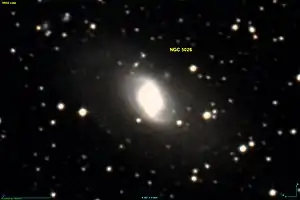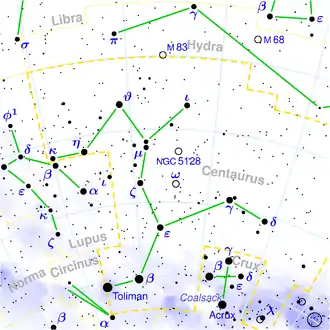NGC 5026
NGC 5026 ist eine 11,6 mag helle Balkenspiralgalaxie vom Hubble-Typ SBa im Sternbild Zentaur, die etwa 151 Millionen Lichtjahre von der Milchstraße entfernt ist.
| Galaxie NGC 5026 | |
|---|---|
 | |
| AladinLite | |
| Sternbild | Zentaur |
| Position Äquinoktium: J2000.0, Epoche: J2000.0 | |
| Rektaszension | 13h 14m 13,6s[1] |
| Deklination | -42° 57′ 41″[1] |
| Erscheinungsbild | |
| Morphologischer Typ | (RL)SB(r)0^+[1] |
| Helligkeit (visuell) | 11,6 mag[2] |
| Helligkeit (B-Band) | 12,5 mag[2] |
| Winkelausdehnung | 3,3′ × 2,1′[2] |
| Positionswinkel | 52°[2] |
| Flächenhelligkeit | 13,6 mag/arcmin²[2] |
| Physikalische Daten | |
| Zugehörigkeit | LGG 339[1] |
| Rotverschiebung | 0.011838 ±0.000110[1] |
| Radialgeschwindigkeit | (3549 ±33) km/s[1] |
| Hubbledistanz vrad / H0 |
(151 ± 11) · 106 Lj (46,3 ± 3,3) Mpc [1] |
| Geschichte | |
| Entdeckung | John Herschel |
| Entdeckungsdatum | 5. Juni 1834 |
| Katalogbezeichnungen | |
| NGC 5026 • PGC 46023 • ESO 269-73 • MCG -07-27-048 • IRAS 13113-4241 • SGC 131121-4241.8 • GC 3455 • h 3474 • LDCE 0916 NED148 | |
Sie wurde am 5. Juni 1834 von John Herschel mit einem 18-Zoll-Spiegelteleskop entdeckt,[3] der sie dabei mit „pB, R, bM, 40 arcseconds“ beschrieb. Bei einer zweiten Beobachtung notierte er „pB, pL, R, gbM, 50 arcseconds“; seine dritte Notiz lautete „pB, pL, R, gbM, 50 arcseconds, has a star 7th mag 3 degrees N.f. distance = 7.5′“[4].
Weblinks
Einzelnachweise
- NASA/IPAC EXTRAGALACTIC DATABASE
- SEDS: NGC 5026
- Seligman
- Auke Slotegraaf: NGC 5026. Deep Sky Observer's Companion, abgerufen am 24. Februar 2015 (englisch).
This article is issued from Wikipedia. The text is licensed under Creative Commons - Attribution - Sharealike. The authors of the article are listed here. Additional terms may apply for the media files, click on images to show image meta data.
